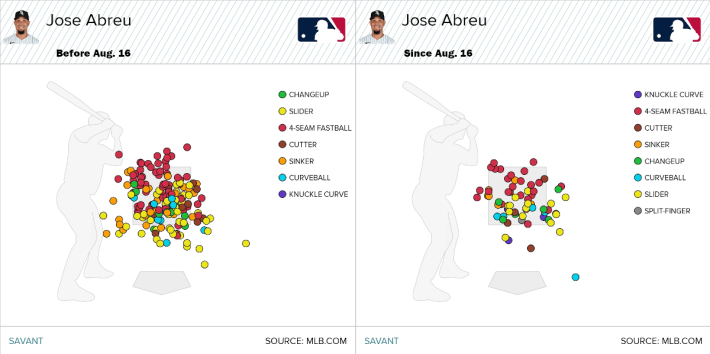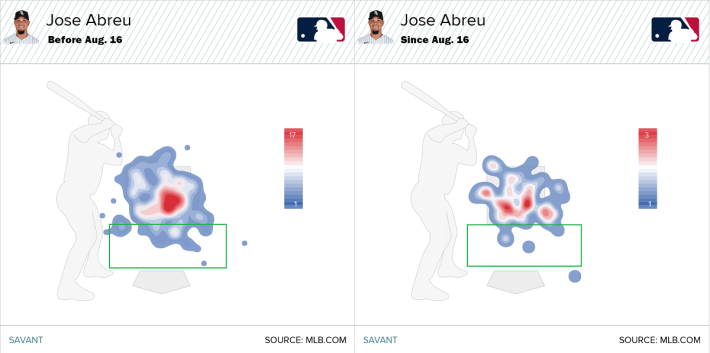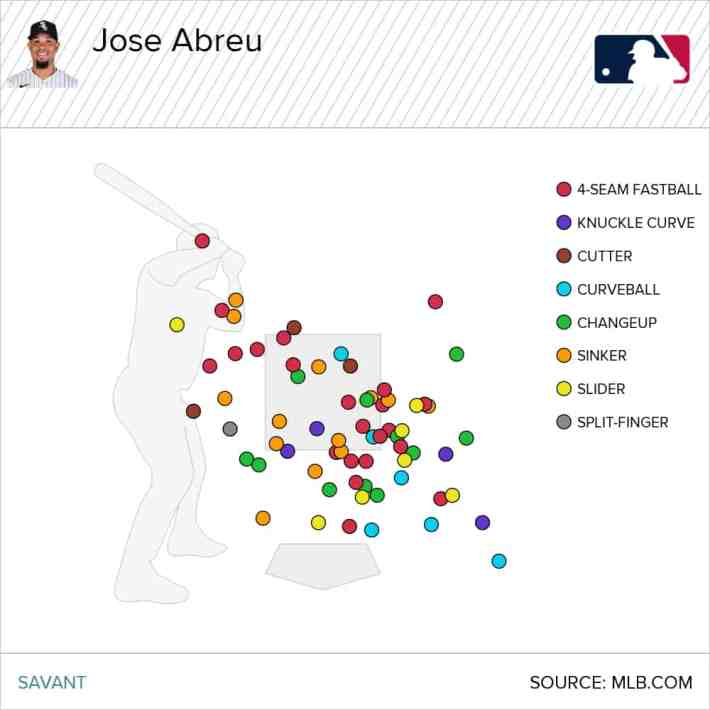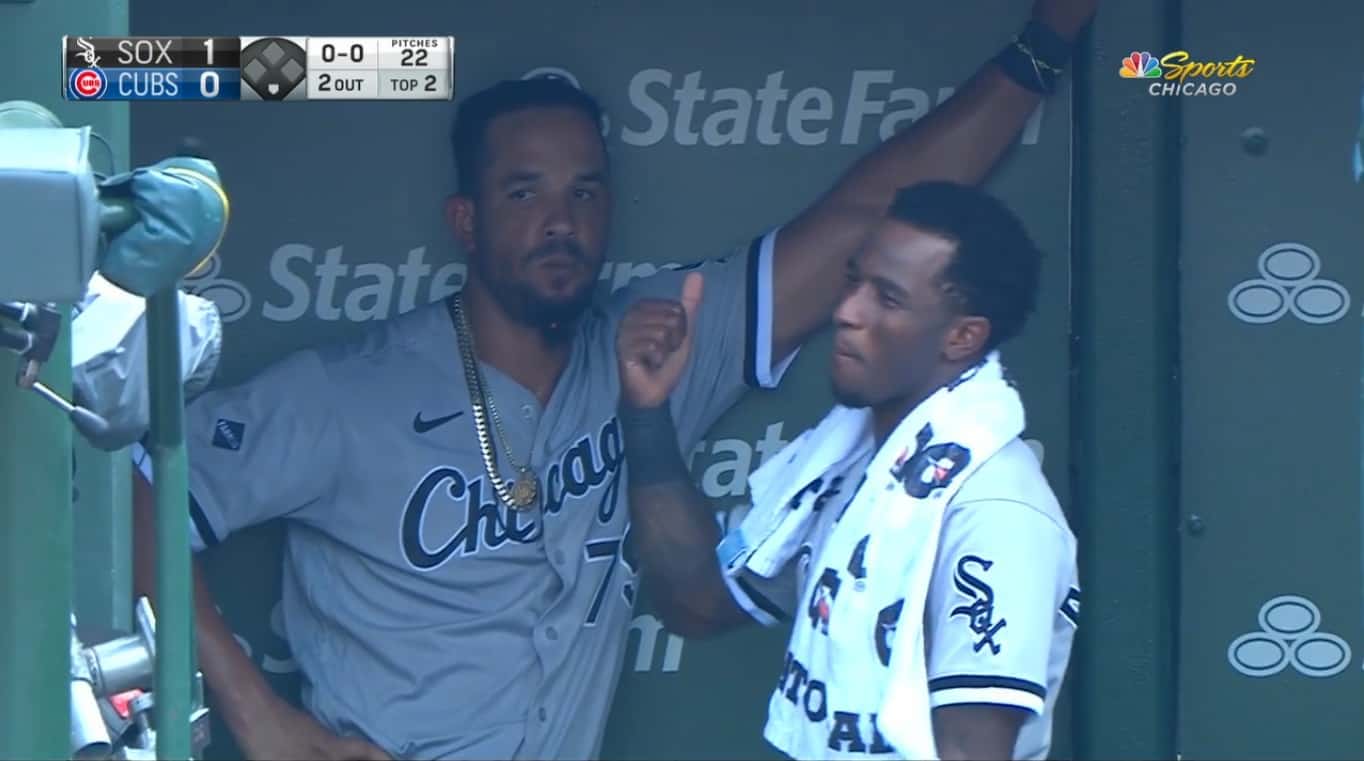In a 60-game season, one week can make a world of a difference for a season's body of work.
In the P.O. Sox bag for Monday's podcast, Mark asked:
Does José Abreu get a statue and/or his number retired if his career ended this year? If no what does the rest of his career need to look like in order for either of those to happen?
When Abreu was hitting .247/.289/.412 through the desultory doubleheader against St. Louis, this question could have been treated as "How much does Jerry Reinsdorf's affection dictate how much the next two years play out?"
Now that Abreu is hitting .322/.365/.669 with league-leading totals in the homer and RBI columns after eight crazy days and nights, that question can be presented without cynical trappings.
Abreu pulled himself from one extreme to another with a week unlike any other. He went 17-for-33, and 11 of those hits went for extra bases. Of those 11 extra-base hits, eight of them left the yard. Of those eight homers, four were hit in consecutive plate appearances at Wrigley Field Saturday into Sunday.
On FanGraphs, you can sort league leaders over a certain date range. Doing so for Abreu over these eight days shows him astride the leaderboard in the following categories (accompanied by runners up).
- Home runs: 8 (three-way tie with 5)
- RBI: 16 (Randal Grichuk, 14)
- WAR: 1.3 (Kyle Lewis, 1.0)
We'd talked earlier this month about Abreu's defense, and how the defensive penalty for first basemen makes it hard for them to register an impressive WAR. Hitting .515/.556/1.333 is the easiest way to solve that problem.
But how did Abreu get in the position of doing so much damage? He's been able to resist more of the pitches he'd been beating into the ground. Here's his swing chart through the St. Louis doubleheader compared to what he's offered at since.

If you'd rather see that in heat map form, with pitches below the strike zone highlighted:

This is mostly a product of better selectivity, but it also happens that he also hadn't seen a whole lot of those tempting sliders. Here's a chart of all the pitches he's taken over the last eight games:

The hyper-aggressive swing chart above made me look for yellow and blue dots on this chart, and there aren't many of them that are both low and over the plate. It's probably easier to hit when he isn't seeing many of the particular pitch giving him fits. Some of Abreu's successes came on flat-out pitcher failures, none more pronounced than this 0-2 curveball from Rowan Wick for Abreu's second homer on Saturday.
But he can't control the pitches he's seeing, just what he does with the ones he gets (looking at you, Nomar Mazara). And that leaves one to be heartened with the walk Abrew drew from Craig Kimbrel in the eighth inning. He fouled back the only damageable pitch, then resisted every breaking ball that followed. As cool as it would've been for Abreu to deliver a game-changing hit, Kimbrel only offered him the opportunity ground out or strike out. Abreu passed.
* * * * * * * * *
Abreu's selectivity fluctuates over the course of the season along with the quality of competition, and I'd imagine another wave of fastball-slider righties to be accompanied by a dip in production. That said, I'm open to the idea of a real revival, if only because enough variables in this season have changed, including more pitches poorly executed. Keeping it only to elements in the White Sox dugout, we're looking at...
Lineup support: When Abreu expands the strike zone, it's usually explained away as a desire to be The Guy. With the White Sox outhomering opponents 27-2 over their seven-game winning streak, perhaps that's ample evidence that there are other Guys abound.
Hitting coach: It's too soon and weird to expect Frank Menechino to make a detectable difference over Todd Steverson, but his general level of irritation even during upswings suggests a different voice at the least, and maybe higher standards for the process beyond that.
“Everybody’s starting to barrel balls, guys are starting to hit balls out of the park, and I’m over there bitching, saying, ‘We’ve got to stop striking out,'” hitting coach Frank Menechino said. “That’s the tug and pull that’s going on here. Sometimes I’m the killjoy.”
Physical condition: Fully aware of the Best Shape of His Life trap, Abreu is playing leaner than usual.
Even if you're inclined to emphasize age (33) over weight, better conditioning can't hurt. I wouldn't take look-good-play-good as a standalone reason for his improvement, but package it with a season that's nearly a third of the 162-game grind with all the cold-weather games removed, and I think he has multiple reasons for being readier to combat the age curve at this juncture.
Abreu's sluggish start was hard to watch, but it also made it easier to appreciate his season-reversing surge. Declines are a real threat. Then again, the White Sox were able to enjoy an early-30s revival from a right-handed first baseman last decade, so perhaps Abreu has his own Konerkossaince in him.
To circle back to the question from Mark at the top, I'd say Abreu is in "unofficial number retirement" territory at the moment. Nobody wore No. 79 before him, so I don't think a Reinsdorf team would let somebody wear No. 79 after him, although they'd come short of posting his number on the wall. If he can somehow summon peak Pito powers here and there while enjoying a postseason run or three, greater honors require less generosity from the chairman than usual.
Update: I think everybody assumed Abreu would receive this honors, but it's official now:





